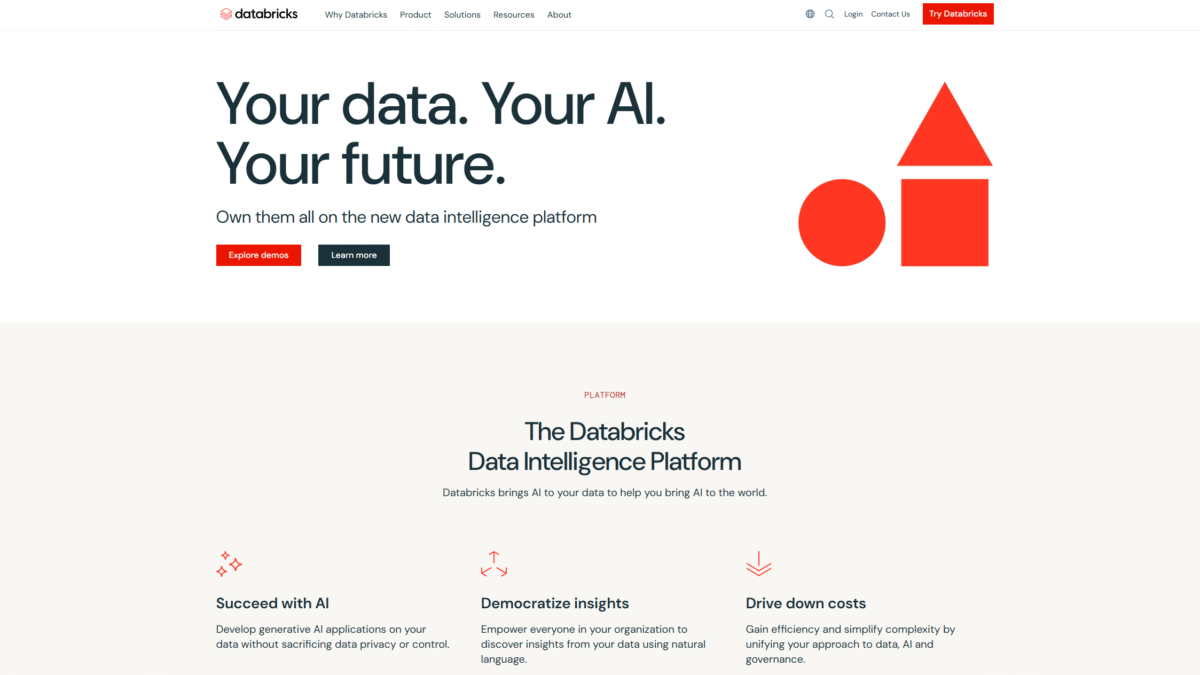
Drive Scalable AI with Unified Big Data Analytics
Searching for the ultimate guide to big data in 2024? You just landed on the right page. I’ll walk you through how organizations harness big data to build scalable AI solutions with Databricks. Try Databricks for Free Today
Managing and governing vast volumes of big data can feel overwhelming. You need a unified, secure environment that keeps data lineage, quality, and privacy intact. Databricks has been empowering enterprises for years—trusted by Fortune 500 companies and recognized with industry awards—to simplify big data analytics and accelerate AI. When you’re ready to build better AI on reliable data, Try Databricks for Free Today.
What is Databricks?
Databricks is a cloud-based Data Intelligence Platform that unifies big data engineering, data science, analytics, and AI workloads. By providing integrated tools for data ingestion, ETL, governance, and model deployment, Databricks helps enterprises turn raw big data into actionable insights and production-ready AI applications without sacrificing control or security.
Databricks Overview
Founded in 2013 by the original creators of Apache Spark, Databricks set out to simplify big data processing and democratize analytics. Its mission: help every organization build and scale data-driven applications in a secure, governed environment.
Over the years, Databricks pioneered the lakehouse architecture, combined data warehousing with data lakes, and introduced generative AI capabilities. Today, the platform supports massive deployments across AWS, Azure, and Google Cloud, processing petabytes of big data and powering advanced machine learning for global enterprises.
Pros and Cons
Scalable Big Data Processing – Effortlessly handle petabyte-scale data with auto-scaling compute and optimized storage.
Unified Platform – Break down silos between data engineering, analytics, and AI teams.
Data Governance and Lineage – Maintain full visibility into data transformations and ensure compliance.
Native ML and GenAI Tools – Built-in experiment tracking, model training, and deployment at scale.
Multi-Cloud Flexibility – Run workloads on AWS, Azure, or Google Cloud with unified pricing and management.
Interactive Notebooks – Collaborate in Python, SQL, R, and Scala with real-time sharing and version control.
Robust Integrations – Plug into BI tools, data ingestion services, and governance frameworks you already use.
Complexity for Small Teams – The platform’s depth can be overwhelming for very small organizations with limited data engineering resources.
Cost Management – Pay-as-you-go billing requires careful cluster configuration to avoid unexpected charges.
Features
Databricks delivers a rich set of capabilities tailored for big data analytics and AI.
Create, Tune and Deploy Generative AI Models
Leverage built-in tools to fine-tune and serve foundation models on your data.
- Pre-built connectors to popular LLMs and vector databases
- Experiment tracking to compare model versions
- One-click deployment with autoscaling inference clusters
Automate Experiment Tracking and Governance
Keep every experiment reproducible and auditable.
- Automatic metadata capture for data inputs, code, and hyperparameters
- Role-based access controls to protect sensitive data
- Lineage visualization for end-to-end workflows
Deploy and Monitor Models at Scale
Operationalize machine learning with confidence.
- Continuous model monitoring with drift detection
- Integrated CI/CD pipelines for ML
- Alerting and logging for production workloads
Databricks Pricing
Databricks offers flexible, usage-based pricing across all clouds. Choose pay-as-you-go or commit to consumption levels for additional savings.
Pay as You Go
Only pay for the Databricks Units (DBUs) you consume, billed per second. No upfront commitments required.
- Ideal for startups and pilot projects
- Scale resources up or down on demand
Committed Use Contracts
Lock in discounted rates by committing to minimum DBU usage over 1–3 years.
- Greater savings with higher commitments
- Flexible across multiple cloud providers
Databricks Is Best For
Databricks empowers a variety of roles to extract maximum value from big data.
Data Engineers
Build reliable ETL pipelines, process streaming data, and orchestrate complex workflows in a unified environment.
Data Scientists
Experiment with large datasets interactively, leverage built-in ML frameworks, and deploy models without infrastructure overhead.
Business Analysts
Run SQL analytics directly on big data, visualize insights, and share dashboards without moving data out of the lakehouse.
Benefits of Using Databricks
When you adopt Databricks for your big data and AI initiatives, you unlock:
- End-to-end integration – From data ingestion to model monitoring, manage the entire workflow in one platform.
- Improved productivity – Collaborative notebooks and automated governance reduce manual friction.
- Cost efficiency – Optimize compute and storage spend with per-second billing and commitment discounts.
- Scalability – Seamlessly grow from terabytes to petabytes of data without rearchitecting.
- Enterprise-grade security – Fine-grained access controls, encryption, and audit logs keep data safe.
Customer Support
Databricks provides 24/7 support through email, chat, and phone. Their dedicated customer success teams help you onboard quickly and resolve issues with production workloads.
Premium support tiers include a named technical account manager and expedited SLAs. Community forums and extensive documentation round out the assistance ecosystem.
External Reviews and Ratings
Analysts often rate Databricks highly for its unified lakehouse architecture and robust ML tooling. Users praise the platform’s scalability, collaboration features, and integration capabilities.
Some feedback notes a learning curve for newcomers and the importance of cost monitoring. Databricks addresses these concerns with guided tutorials, usage dashboards, and best-practice templates.
Educational Resources and Community
Databricks Academy offers self-paced courses, instructor-led training, and certification paths. The official blog covers big data analytics, ML engineering, and generative AI use cases.
- Webinars with industry experts
- Community-hosted meetups and hackathons
- Active Slack and Stack Overflow channels
Conclusion
Unified big data analytics is the foundation for scalable, reliable AI. Databricks brings your data, AI, and governance into one seamless platform—so you can focus on insights and innovation. To start transforming your data strategy today, Try Databricks for Free Today and see the impact of a data-centric approach.
Ready to accelerate your AI journey with big data? Try Databricks for Free Today
